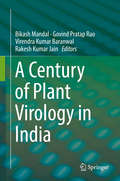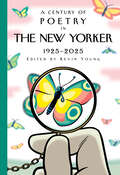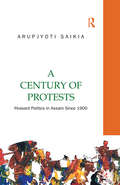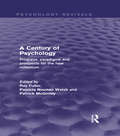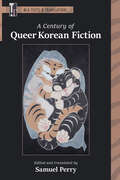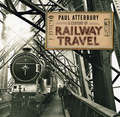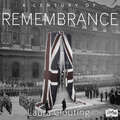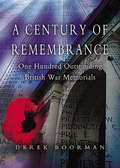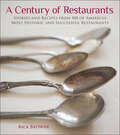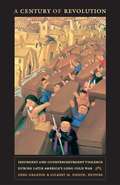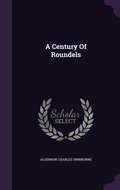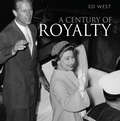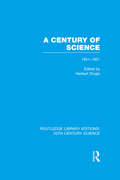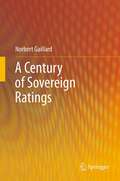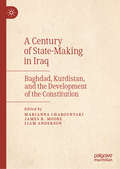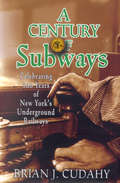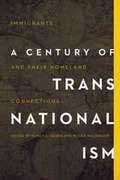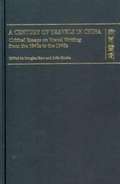- Table View
- List View
A Century of Parasitology
by Gerald W. Esch John Janovy Jr.Reviews key areas in ecological, medical and molecular parasitology Features essays from some of the world's leading parasitologists Each topic is set in context by featuring a key paper from the Journal of Paraistology over the past 100 years
A Century of Plant Virology in India
by Bikash Mandal Govind Pratap Rao Virendra Kumar Baranwal Rakesh Kumar JainThe book is a compilation of research work carried out on plant viruses during past 100 years in India. Plant viruses are important constraints in Indian agriculture. Tropical and sub-tropical environments and intensive crop cultivation practices ideally favours perpetuation of numerous plant viruses and their vectors in India, which often cause wide spread crop losses. Of all the plant pathogens, studies of plant viruses have received a special attention as they are difficult to manage. A large body of literature has been published on the plant virus research from India during past 100 years; however the information is so far not available in one place. This book provides comprehensive information on the biology, molecular biology, epidemics, crop losses, diagnosis and management of viruses and viroids occurring in India. Description of properties of the viruses are provided in the chapters comprising of different genera such as Allexivirus, Begomovirus, Babuvirus, Badnavirus, Carlavirus, Carmovirus, Cucumovirus, Closterovirus, Ilavirus, Mandrivirus, Potyvirus, Tospovirus, Tungrovirus and Sobemovirus. Virus-vector research related to aphid, thrips and whitefly is discussed. The work on the management aspects of plant viral diseases has been described with reference to the conventional, antiviral and transgenic approaches. Further, the quarantine mechanism developed in India for the exclusion of viruses and vectors has also been included. The book also provides useful information about the capacity building on the research and education on Plant Virology in India. Overall, the book covers a wide range of accounts of research findings and innovations in Plant Virology in India during past 100 years. The book will be a resourceful reference to the students, scientists, agricultural professionals and policy makers.
A Century of Poetry in The New Yorker: 1925-2025
by New Yorker Magazine IncEdited by the magazine&’s poetry editor, Kevin Young, a celebratory selection from one hundred years of influential, entertaining, and taste-making verse in The New YorkerSeamus Heaney, Dorothy Parker, Louise Bogan, Louise Glück, Randall Jarrell, Langston Hughes, Derek Walcott, Sylvia Plath, W. S. Merwin, Czesław Miłosz, Tracy K. Smith, Mark Strand, E. E. Cummings, Sharon Olds, Franz Wright, John Ashbery, Sandra Cisneros, Amanda Gorman, Maggie Smith, Kaveh Akbar: these stellar names make up just a fraction of the wonderfulness that is present in this essential anthology.The book is organized into sections honoring times of day (&“Morning Bell,&” &“Lunch Break,&” &“After-Work Drinks,&” &“Night Shift&”), allowing poets from different eras to talk back to one another in the same space, intertwined with chronological groupings from the decades as they march by: the frothy 1920s and 1930s (&“despite the depression,&” Young notes), the more serious &’40s and &’50s (introducing us to the early greats of our contemporary poetry, like Elizabeth Bishop, W. S. Merwin, and Adrienne Rich), the political &’60s and &’70s, the lyrical &’80s and &’90s, and then the 2000s&’ with their explosion of greater diversity in the magazine, greater depth and breadth. Inevitably, we see the high points when poems spoke directly into, about, or against the crises of their times—the war poetry of W. H. Auden and Karl Shapiro; the remarkable outpouring of verse after 9/11 (who can forget Adam Zagajewski&’s &“Try to Praise the Mutilated World&”?); and more recently, stunning poems in response to the cataclysmic events of COVID and the murder of George Floyd.The magazine&’s poetic influence resides not just in this historical and cultural relevance but in sheer human connection, exemplified by the passing verses that became what Young calls &“refrigerator poems&”: the ones you tear out and affix to the fridge to read again and again over months and years. Our love for that singular Billy Collins or Ada Limón poem—or lines by a new writer you&’ve never heard of but will hear much more from in the future—is what has made The New Yorker a great organ for poetry, a mouthpiece for our changing culture and way of life, even a mirror of our collective soul.
A Century of Protests: Peasant Politics in Assam Since 1900
by Arupjyoti SaikiaAddressing an important gap in the historiography of modern Assam, this book traces the relatively unexplored but profound transformations in the agrarian landscape of late- and post-colonial Assam that were instrumental in the making of modern Assamese peasantry and rural politics. It discusses the changing relations between various sections of peasantry, state, landed gentry, and politics of different ideological hues — nationalist, communist and socialist — and shows how a primarily agrarian question concerning peasantry came to occupy the centre stage in the nationalist politics of the state. It will especially interest scholars of history, agrarian and peasant studies, sociology, and contemporary politics, as also those concerned with Northeast India.
A Century of Psychology: Progress, paradigms and prospects for the new millennium (Psychology Revivals)
by Patricia Noonan Walsh Patrick McGinley Ray FullerPsychology has influence in almost every walk of life. Originally published in 1997, A Century of Psychology is a review of where the discipline came from, where it had reached and where the editors anticipated it may go. Ray Fuller, Patricia Noonan Walsh and Patrick McGinley assembled an internationally recognised team of mainly European experts from the major applications and research areas of psychology. They begin with a critical review of methodology and its limitations and plot the course of gender and developmental psychology. They go on to include discussion of learning, intellectual disability, clinical psychology and the emergence of psychotherapy, educational psychology, organizational psychology, cognitive psychology, neuropsychology and many other topics, in particular community psychology, perception and alternative medicine. Enlightening, reflective and sometimes provocative, A Century of Psychology is required reading for anyone involved in psychology as a practitioner, researcher or teacher. It is also a lively introduction for those new to the discipline.
A Century of Queer Korean Fiction (MLA Texts and Translations Series)
by Samuel PerryFollowing decades of LGBTQ+ activism, South Korea has seen a flowering of queer literature, film, and Internet culture. Many openly gay, lesbian, transgender, and other queer Korean writers find themselves in the national and international spotlight. But the rich variety of queer representation also extends into the Korean past, as this volume illustrates. <p><p> Beginning with contemporary works of fiction by Kim Bi, Sang Young Park, and Yi Seoyoung and reaching back through the last century, this collection includes works by the canonical authors Yi Kwangsu, Yi Kiyŏng, Ch'oe Chŏnghŭi, and O Chŏnghŭi as well as stories by Yu Sŭngjin and Kim Sunyŏng that have been recovered from archives. The introduction places these representations of queerness in their historical and cultural context, explores the sometimes problematic norms found in the stories, and considers the potential these texts hold for destabilizing binaries of sex and gender. <p><p> This volume contains the following works: "Yundo Is Back" (2017), "My Queer Year of Junior High" (2016), "Saltwater Baths" (2006), "Traditional Solo" (1970), "Struggling amid This Despair" (1965), "Spring" (1950), selections from the novel Spring (1940), "Dear Sister, I'm Off to the Moon" (1933), and "Yun Kwangho" (1918).
A Century of Railway Travel
by Paul AtterburyFrom the Edwardian golden age of steam to the present, no mode of travel has captured the hearts of the British people like the railways. In wartime and peace, along major routes and minor, steam, diesel and electric trains, have moved goods, taken commuters to work or families on holidays - a constant presence in an always changing way of life. A Century of Railway Travel tells the story of one hundred years of Britain's railway heritage using striking full-page imagery with commentary from author Paul Atterbury who explains the controversial history and unique appeal of the railways. His expert eye steers the reader through the last hundred years, from the heyday of steam to the tragedy that was Beeching and rail's recent revival. The book stops to consider the great steam engines, the drivers, luggage, passengers, postcards, tickets, station scenes and carriage interiors we all like to remember.
A Century of Remembrance
by Laura CloutingThe scale and nature of the First World War, and the manner in which the dead were treated, created conditions in which a very particular language of grief and remembrance of the war dead flourished.A Century of Remembrance explores the deeply personal ways in which people mourned their loved ones, and memorialised them, and examines the cornerstones of national-scale remembrance that took hold in Britain throughout the 1920s, from the poppy to the cenotaph.(P)2020 Headline Publishing Group Limited
A Century of Remembrance: One Hundred Outstanding British War Memorials
by Derek BoormanA Century of Remembrance is a study of one hundred outstanding United Kingdom war memorials which commemorate 20th century conflicts from the Boer War to the Falklands and Gulf wars. The first described is a Boer War memorial unveiled on 5 November 1904, and the last is the Animals in War memorial unveiled in London on 24 November 2004.The memorials chosen are listed as near as possible in chronological order and represent different wars, different artists, different areas of the country, and a variety of types of memorial. In category they range from individual to national memorials and include memorials in schools, churches and places of work, and examples representing communities and the armed services. In form they are from statues and stained glass windows to arches, obelisks and cenotaphs, and from cloisters and chapels to art galleries and gardens and even a carillon.
A Century of Repression: The Espionage Act and Freedom of the Press (The History of Media and Communication)
by Ralph Engelman Carey ShenkmanA Century of Repression offers an unprecedented and panoramic history of the use of the Espionage Act of 1917 as the most important yet least understood law threatening freedom of the press in modern American history. It details government use of the Act to control information about U.S. military and foreign policy during the two World Wars, the Cold War, and the War on Terror. The Act has provided cover for the settling of political scores, illegal break-ins, and prosecutorial misconduct.
A Century of Restaurants: Stories and Recipes from 100 of America's Most Historic and Successful Restaurants
by Rick BrowneFrom the public television host, a tour of the US’s oldest and greatest dining spots—with “delightful tales, delicious recipes, and hundreds of photographs” (Ted Allen, host of Food Network’s Chopped).Come along on a pilgrimage to some of the oldest, most historic restaurants in America. Each is special not only for its longevity but also for its historic significance, interesting stories, and, of course, wonderful food. The oldest Japanese restaurant in the country is profiled, along with stagecoach stops, elegant eateries, barbecue joints, hamburger shops, cafes, bars and grills, and two dueling restaurants that both claim to have invented the French dip sandwich.The bestselling author and host/producer of Barbecue America shares the charm, history, and appeal that made these establishments, some as many as three hundred years old, successful. Each profile contains a famous recipe, the history of the restaurant, a look at the restaurant today, descriptions of some of its signature dishes, fun facts that make each place unique, and beautiful photos. It’s all you need for an armchair tour of one hundred restaurants that have made America great.“Browne spent three years traveling more than 46,000 miles to profile the 100 restaurants, inns, taverns and public houses he selected as being the most historic, most interesting and most successful.” —Orlando Sentinel“It is Browne’s exploration of the history behind each place that I found most interesting…The White Horse Tavern gave him the Beef Wellington recipe. Peter Luger, the legendary Brooklyn Steakhouse, shared one for German Fried Potatoes and Katz’s Delicatessen in New York City offered Katz’s Noodle Kugel. And, Ferrara in Little Italy in New York City parted with its cannoli recipe.” —Sioux City Journal“Ask any chef: It’s not easy keeping a restaurant alive for a week, let alone a year or a decade. So what does it take to last a century? After five years of criss-crossing the country and gobbling up regional specialties from chowder to chili, Rick Browne reveals the answer to that question.” —Ted Allen, host of Food Network’s Chopped
A Century of Restaurants: Stories and Recipes from 100 of America's Most Historic and Successful Restaurants
by Rick BrowneFrom the public television host, a tour of the US’s oldest and greatest dining spots—with “delightful tales, delicious recipes, and hundreds of photographs” (Ted Allen, host of Food Network’s Chopped).Come along on a pilgrimage to some of the oldest, most historic restaurants in America. Each is special not only for its longevity but also for its historic significance, interesting stories, and, of course, wonderful food. The oldest Japanese restaurant in the country is profiled, along with stagecoach stops, elegant eateries, barbecue joints, hamburger shops, cafes, bars and grills, and two dueling restaurants that both claim to have invented the French dip sandwich.The bestselling author and host/producer of Barbecue America shares the charm, history, and appeal that made these establishments, some as many as three hundred years old, successful. Each profile contains a famous recipe, the history of the restaurant, a look at the restaurant today, descriptions of some of its signature dishes, fun facts that make each place unique, and beautiful photos. It’s all you need for an armchair tour of one hundred restaurants that have made America great.“Browne spent three years traveling more than 46,000 miles to profile the 100 restaurants, inns, taverns and public houses he selected as being the most historic, most interesting and most successful.” —Orlando Sentinel“It is Browne’s exploration of the history behind each place that I found most interesting…The White Horse Tavern gave him the Beef Wellington recipe. Peter Luger, the legendary Brooklyn Steakhouse, shared one for German Fried Potatoes and Katz’s Delicatessen in New York City offered Katz’s Noodle Kugel. And, Ferrara in Little Italy in New York City parted with its cannoli recipe.” —Sioux City Journal“Ask any chef: It’s not easy keeping a restaurant alive for a week, let alone a year or a decade. So what does it take to last a century? After five years of criss-crossing the country and gobbling up regional specialties from chowder to chili, Rick Browne reveals the answer to that question.” —Ted Allen, host of Food Network’s Chopped
A Century of Revolution: Insurgent and Counterinsurgent Violence During Latin America's Long Cold War
by Greg Grandin Gilbert M. JosephLatin America experienced an epochal cycle of revolutionary upheavals and insurgencies during the twentieth century, from the Mexican Revolution of 1910 through the mobilizations and terror in Central America, the Southern Cone, and the Andes during the 1970s and 1980s. In his introduction to A Century of Revolution, Greg Grandin argues that the dynamics of political violence and terror in Latin America are so recognizable in their enforcement of domination, their generation and maintenance of social exclusion, and their propulsion of historical change, that historians have tended to take them for granted, leaving unexamined important questions regarding their form and meaning. The essays in this groundbreaking collection take up these questions, providing a sociologically and historically nuanced view of the ideological hardening and accelerated polarization that marked Latin America's twentieth century. Attentive to the interplay among overlapping local, regional, national, and international fields of power, the contributors focus on the dialectical relations between revolutionary and counterrevolutionary processes and their unfolding in the context of U. S. hemispheric and global hegemony. Through their fine-grained analyses of events in Chile, Colombia, Cuba, El Salvador, Guatemala, Mexico, Nicaragua, and Peru, they suggest a framework for interpreting the experiential nature of political violence while also analyzing its historical causes and consequences. In so doing, they set a new agenda for the study of revolutionary change and political violence in twentieth-century Latin America. Contributors Michelle Chase Jeffrey L. Gould Greg Grandin Lillian Guerra Forrest Hylton Gilbert M. Joseph Friedrich Katz Thomas Miller Klubock Neil Larsen Arno J. Mayer Carlota McAllister Jocelyn Olcott Gerardo Rnique Corey Robin Peter Winn
A Century of Roundels
by Algernon Charles SwinburneSongs light as these may sound, though deep and strong The heart spake through them, scarce should hope to please Ears tuned to strains of loftier thoughts than throng Songs light as these. <P> <P> Yet grace may set their sometime doubt at ease, Nor need their too rash reverence fear to wrong The shrine it serves at and the hope it sees. For childlike loves and laughters thence prolong Notes that bid enter, fearless as the breeze, Even to the shrine of holiest-hearted song, Songs light as these. (Typographical errors above are due to OCR software and don't occur in the book.)
A Century of Royalty
by Edward WestOver the last century Britain has witnessed a royal family saga compelling, tumultuous and heartwarming. The constitution has been thrown into crisis by an abdication, royal divorces have become commonplace, coronations and jubilees have brought the nation together - and though Princess Diana's death precipitated perhaps the most serious turn in public opinion yet, the Windsors' place in our hearts was confirmed beyond any doubt by Elizabeth II'sDiamond Jubilee and the birth of the Duke and Duchess of Cambridge's son, Prince George. With full-page illustrations from the Daily Mirror's archives and illuminating explanatory text, this book is a unique look at one hundred years of royalty in Britain. The British Royal Family: beloved worldwide, poised and gracious, and above all resilient. With striking images from the Daily Mirror's famous archive and expert text from Ed West, A Century of Royalty looks from unexpected angles at these fascinating lives, controversies and traditions, from Edward VII's coronation to the birth of Prince George in 2013.
A Century of Science 1851-1951 (Routledge Library Editions: 20th Century Science)
by Herbert DingleFirst published in 1951 to coincide with the British Festival, this book explores the developments in science which had occurred since the Great Exhibition of 1851. Covering the full range of scientific development which had emerged in that time – from fundamental physics to evolution and genetics, and from geology to medical surgery – this accessible collection of essays charts with impressive comprehension and clarity the momentous changes which had occurred in the pursuit of science since the mid-nineteenth century, and ably demonstrates the appropriateness of citing the twentieth century as the advent of the scientific age. A Century of Science will appeal to those interested in the history of science, those wishing to ground their knowledge of specific scientific disciplines in a broader understanding of the subject, and also to the general reader who values scientific progress and the questions it continues to raise.
A Century of Sea Travel: Personal Accounts from the Steamship Era
by Christopher Deakes Tom StanleyThis &“handsome volume&” offers a &“lavishly illustrated&” journey back to the golden age of steam travel through first-hand accounts and images of the passengers (Bruce Peter, author of Ship Style). A Century of Sea Travel is an eye-opening voyage through the golden years of the passenger steamship, a voyage described by the very travelers who sailed on these magnificent engineering marvels. In memoirs and letters home, diaries and the backs of postcards, the recorded experiences of every aspect of steamship travel are here relived: from details of the ships, the crew, and fellow passengers; to the food and entertainment on board; to tales of romance, accidents, and disasters; and of being dreadfully sick during storms at sea. The writers were emigrants or colonial rulers, men of letters, young men seeking their fortune, wives on their way to new homes abroad; some were rich, many were poor and escaping the hardship of downtrodden lives. All had in common the experience of voyaging at sea. Vividly brought to life by full-color and black-and-white postcards, travel posters, promotional brochures, fine art, photographs, maps, luggage labels, health inspection certificates, and itineraries, the authors have woven together word and image into a page-turning narrative that evocatively describes an age (1840–1950) now lost to time.
A Century of Separation Science
by Haleem J. IssaqA Century of Separation Science presents an extensive overview of the critical developments in separation science since 1900, covering recent advances in chromatography, electrophoresis, field-flow fractionation, countercurrent chromatography, and supercritical fluid chromatography for high-speed and high-throughput analysis.
A Century of Service
by David C. ForwardThe story of Rotary International and the Rotarians contributions to the society
A Century of Service: Land-Grant Colleges and Universities, 1890-1990
by Ralph D. Christy Lionel WilliamsonIn 1890 congressional legislation opened a new chapter in the history of higher education by allocating public support for black Land-Grant colleges and universities.These institutions were established to provide training to blacks in the fields of agriculture, home economics, the mechanical arts, and other useful professions. For a century, these schools have assumed and continue to maintain a unique and important role in affording educational opportunities for thousands of students to whom no other doors would have been opened. A Century of Service is both a history and a celebration of these Land-Grant schools. The work also provides a presentation of views on how their original mission can best be adapted to the challenges of the future. The 1890 Land-Grant institutions are a legacy of what can be accomplished with little more than a determined, tenacious commitment to survive and excel. In spite of unequal financial support, they have succeeded in establishing and building quality resident academic and extension programs on a par with those of other colleges and universities not suffering the same economic limitations. As demonstrated throughout this volume, the 1890 institutions have amassed an impressive record of achievement in the areas of agricultural research, cooperative extension, development of rural communities' support systems, human resources development, resident instruction, international development, and technology and information transfer. In assessing the current state of the schools and looking to the future, the authors seek ways of building upon their strengths and traditions and explore alternative institutional designs to enhance the status and opportunities for African American agricultural scientists and professionals under quite new circumstances. A Century of Service will be of interest to social historians, black studies specialists, agricultural scientists, and educators.
A Century of Sovereign Ratings
by Norbert GaillardThe financial difficulties experienced by Greece since 2009 serve as a reminder that countries (i.e., sovereigns) may default on their debt. Many observers considered the financial turmoil was behind us because major advanced countries had adopted stimulus packages to prevent banks from going bankrupt. However, there are rising doubts about the creditworthiness of several advanced countries that participated in the bailouts. In this uncertain context, it is particularly crucial to be knowledgeable about sovereign ratings. This book provides the necessary broad overview, which will be of interest to both economists and investors alike. Chapter 1 presents the main issues that are addressed in this book. Chapters 2, 3, and 4 provide the key notions to understand sovereign ratings. Chapter 2 presents an overview of sovereign rating activity since the first such ratings were assigned in 1918. Chapter 3 analyzes the meaning of sovereign ratings and the significance of rating scales; it also describes the refinement of credit rating policies and tools. Chapter 4 focuses on the sovereign rating process. Chapters 5 and 6 open the black box of sovereign ratings. Chapter 5 compares sovereign rating methodologies in the interwar years with those in the modern era. After examining how rating agencies have amended their methodologies since the 1990s, Chapter 6 scrutinizes rating disagreements between credit rating agencies (CRAs). Chapters 7 and 8 measure the performances of sovereign ratings by computing default rates and accuracy ratios: Chapter 7 looks at the interwar years and Chapter 8 at the modern era. The two chapters assess which CRA assigns the most accurate ratings during the respective periods. Chapters 9 and 10 compare the perception of sovereign risk by the CRAs and market participants. Chapter 9 focuses on the relation between JP Morgan Emerging Markets Bond Index Global spreads and emerging countries' sovereign ratings for the period 1993-2007. Chapter 10 compares the eurozone members' sovereign ratings with Credit Default Swap-Implied Ratings (CDS-IRs) during the Greek debt crisis of November 2009-May 2010.
A Century of State-Making in Iraq: Baghdad, Kurdistan, and the Development of the Constitution
by Marianna Charountaki James R. Moore Liam AndersonAs an interdisciplinary publication, this book will have a strong international appeal to those across the Middle East who are interested in the complex issues of state-building, democratic transitions and federalism. It will also appeal to the many scholars in North America and Europe engaged in the study of these questions. The search for just and stable constitutional arrangements has been a central feature of political debates in the region and, since the Arab Uprisings, political scientists around the world have focused their attention on changes in the region. Iraq is a fascinating case study of a state that emerged from the mandate system with political institutions derived from Western political ideas, but one where the application of those ideas reflected the historical circumstances and social realities of fragmented community life. Iraq’s political and constitutional problems have been fiercely debated since the Iraq war of 2003, with stuttering attempts to create a new constitutional settlement for Iraq. This book seeks to place these debates in their wider historical and socio-political context and demonstrate how contemporary problems are rooted in Iraq’s political system, state-building processes and unique constitutional past. The volume examines different aspects of Iraq’s struggle to create a coherent state identity through political institutions that can accommodate diversity. This is a topical work with extensive primary-source-based empirical research, alongside the conceptual and theoretical insights offered. Its different approach will be valuable to a variety of audiences, ranging from scholars and students of international politics/relations and law, diplomatic history, and the Middle East, to policymakers and, indeed, beyond to a broader audience of informed non-specialist readers.
A Century of Subways: Celebrating 100 Years of New York's Underground Railways
by Brian J. CudahyThe transit historian and author of Under the Sidewalks of New York delivers a lively and authoritative history of New York City&’s fabled subway. On the afternoon of October 27, 1904, ordinary New Yorkers descended beneath the sidewalks for the first time to ride the electric-powered trains of the newly inaugurated Interborough Rapid Transit System. More than a century later, the subway has expanded greatly, weaving its way into the fabric of New York&’s unique and diverse urban life. In A Century of Subways, transit historian Brian J. Cudahy offers a fascinating tribute to New York&’s storied and historic subway system, from its earliest beginnings and many architectural achievements, to the ways it helped shape today&’s modern metropolis. Taking a fresh look at one of the marvels of the twentieth century, Cudahy creates a vivid sense of this extraordinary system and the myriad ways the city was transformed once New Yorkers started riding below the ground.
A Century of Transnationalism: Immigrants and Their Homeland Connections
by Roger Waldinger Nancy L. GreenThis collection of articles by sociologically minded historians and historically minded sociologists highlights both the long-term persistence and the continuing instability of home country connections. Encompassing societies of origin and destination from around the world, A Century of Transnationalism shows that while population movements across states recurrently produce homeland ties, those connections have varied across contexts and from one historical period to another, changing in unpredictable ways. Any number of factors shape the linkages between home and destination, including conditions in the society of immigration, policies of the state of emigration, and geopolitics worldwide. Contributors: Houda Asal, Marie-Claude Blanc-Chaléard, Caroline Douki, David FitzGerald, Nancy L. Green, Madeline Y. Hsu, Thomas Lacroix, Tony Michels, Victor Pereira, Mônica Raisa Schpun, and Roger Waldinger
A Century of Travels in China
by Douglas Kerr Julia KuehnWritings of travelers have shaped ideas about an evolving China, while preconceived ideas about China also shaped the way they saw the country. A Century of Travels in China explores the impressions of these writers on various themes, from Chinese cities and landscapes to the work of Europeans abroad. From the time of the first Opium War to the declaration of the People's Republic, China's history has been one of extraordinary change and stubborn continuities. At the same time, the country has beguiled, scared and puzzled people in the West. The Victorian public admired and imitated Chinese fashions, in furniture and design, gardens and clothing, while maintaining a generally negative idea of the Chinese empire as pagan, backward and cruel. In the first half of the twentieth century, the fascination continued. Most foreigners were aware that revolutionary changes were taking place in Chinese politics and society, yet most still knew very little about the country. But what about those few people from the English-speaking world who had first-hand experience of the place? What did they have to say about the "real" China? To answer this question, we have to turn to the travel accounts and memoirs of people who went to see for themselves, during China's most traumatic century.

